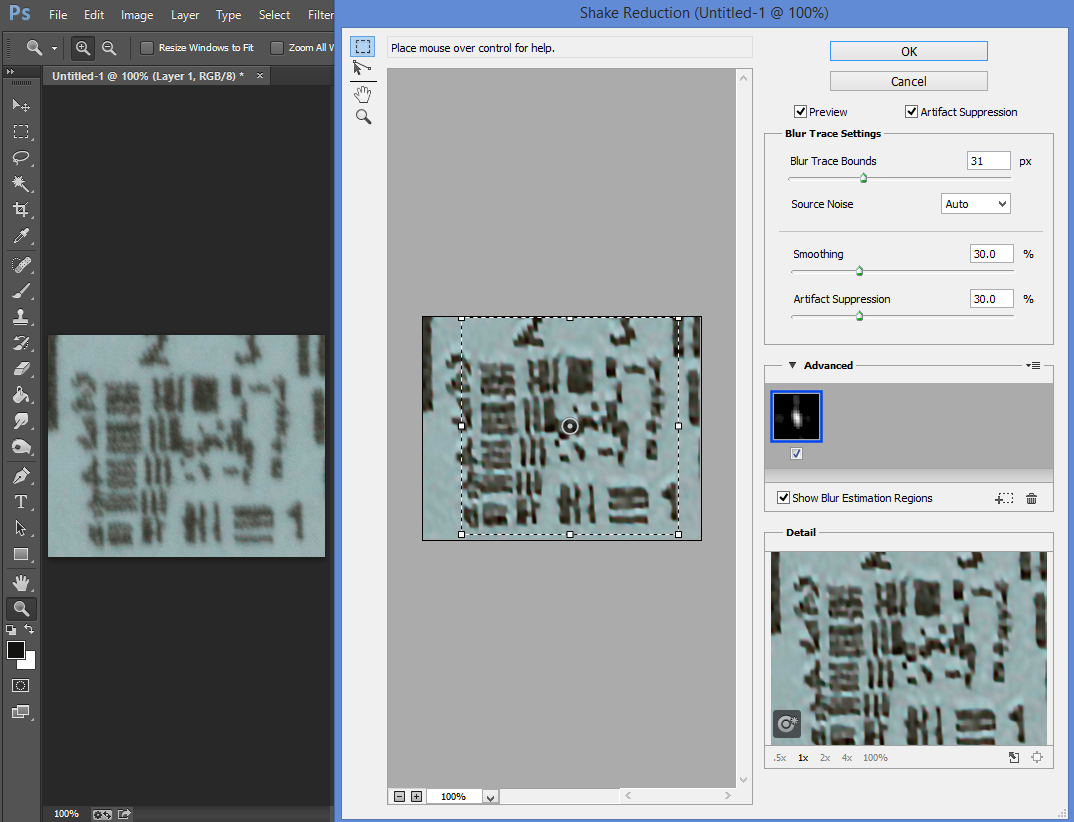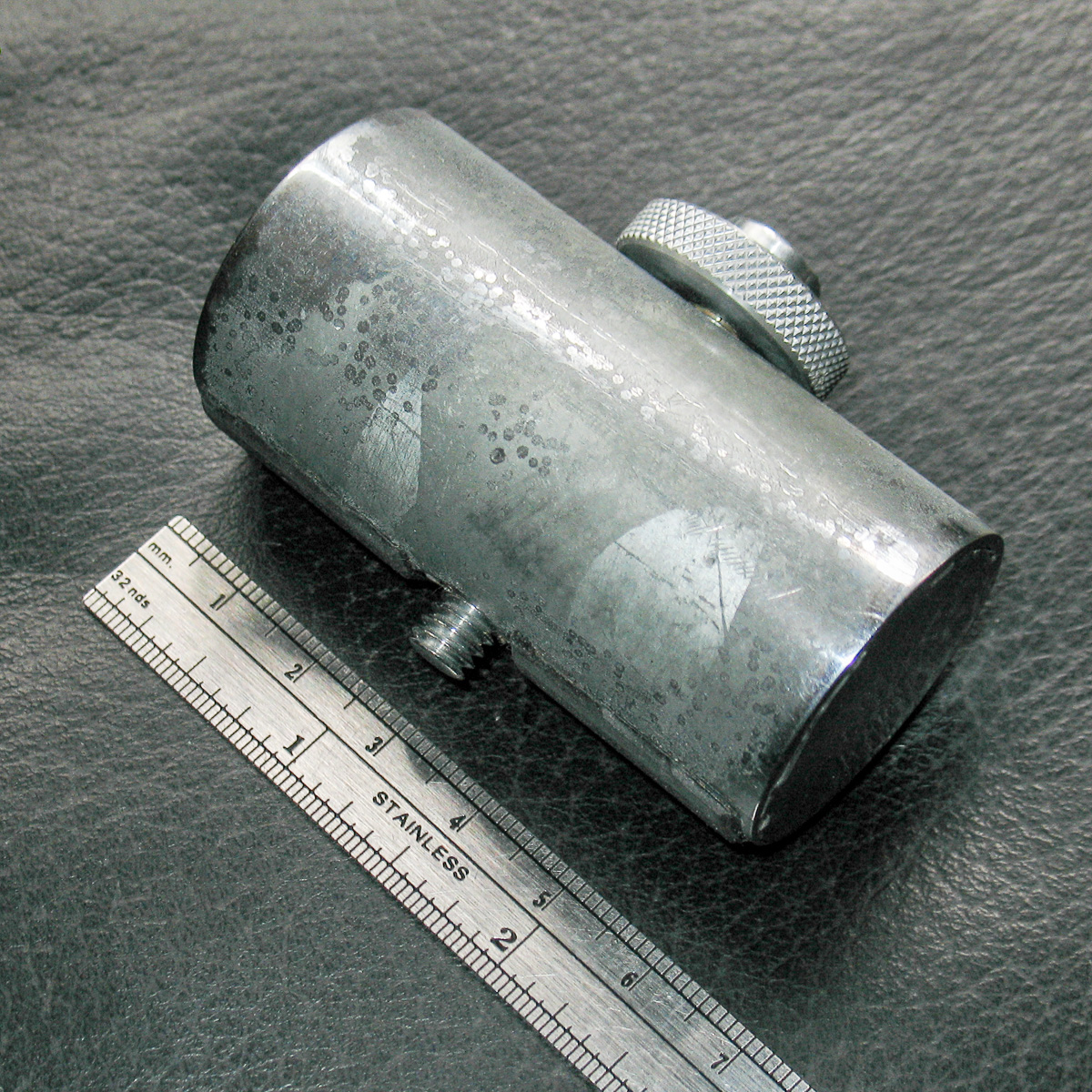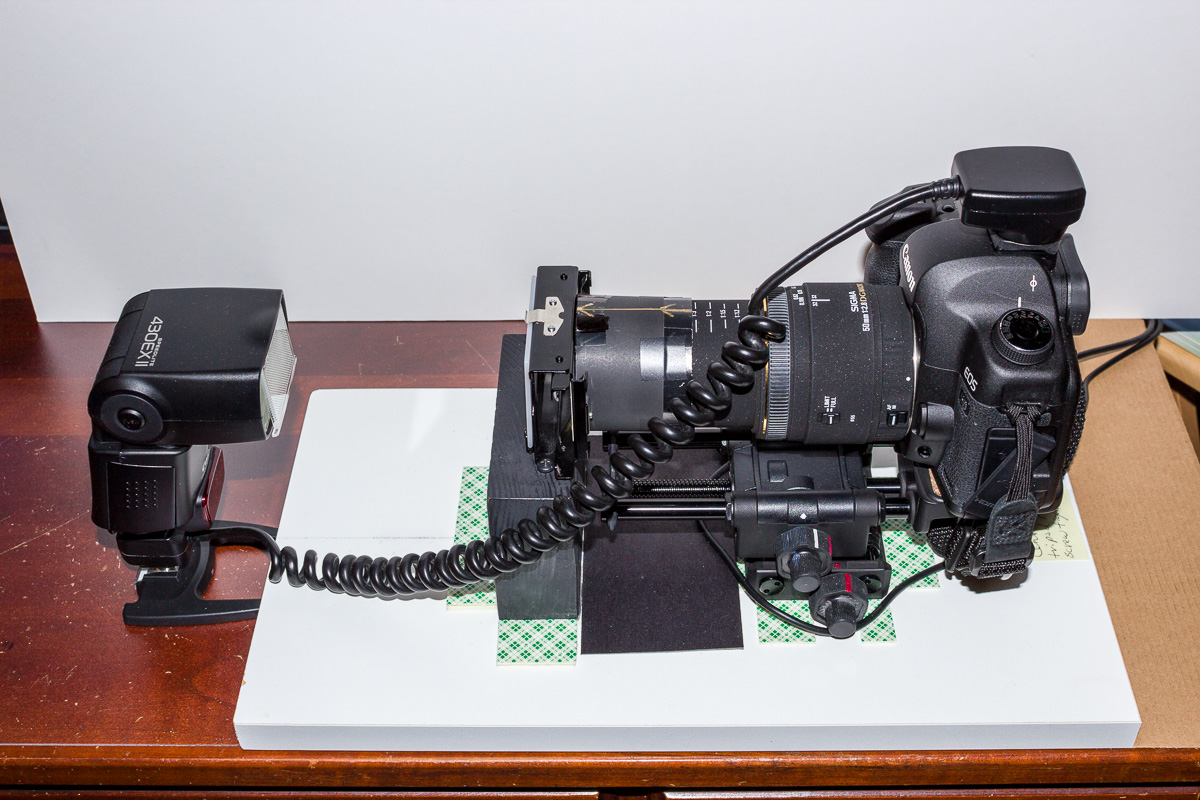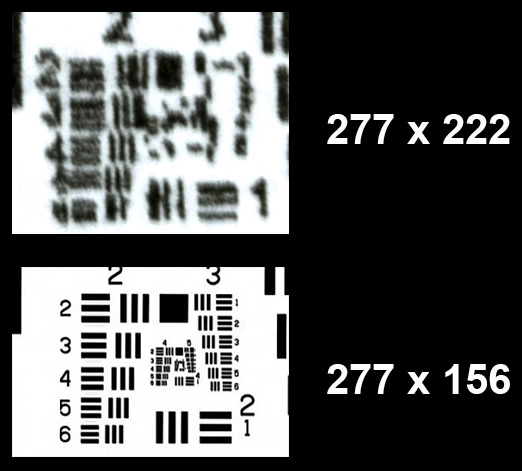- Home
- Lightroom Classic
- Discussions
- Re: Is the shake reduction filter in Lightroom?
- Re: Is the shake reduction filter in Lightroom?
Copy link to clipboard
Copied
Camera motion from mirror and shutter movement is a problem for me with slower shutter speeds with the D800. BIG tripod, mirror lock up and delayed release all help considerablly with the mirror caused camera shake. But camera shake from the shutter release remains. I can see this as a slightly offset "shadow" of the image only in the vertical axis. I am convinced that this shadow is caused by the shutter vibration as using flash or bulb with an external light on/off to control exposure eliminates the shadow. The shadow is enough to degrade image sharpness.
So to me the initial and most important adjustment to D800 raw images would be a shake reduction to correct for the shutter caused camera motion shadow as the very first correction in raw conversion. PS CC has it but it is much too late in the workflow. Seems to me like all image processing would benefit by removing the shutter shadow as a first step.
If shake reduction is not in LR, is there anyway to apply the filter as the very first step in raw processing in PS? If this just can't be done does anyone know of a raw plugin that will add the shake reduction to raw. As a last resort is there any other non Adobe raw converter that has initial shake reduction?
 1 Correct answer
1 Correct answer
PS-CC Shake Reduction makes the image much worse in my opinion: an image with faint blurriness becomes an image with very distinct white and black haloing and if you did this with the raw data, the haloing would result in colored halos.
As Todd says, you'd be better off trying to remove the camera shake from the camera, rather than after the fact with software that is guessing what the shake was like and overdoing the correction. If you look at the link at the top of the page linked in Todd's r
...Copy link to clipboard
Copied
Once the image has been opened in Photoshop, it is no longer raw image data. I understand that Photoshop will indicate that it is a raw file, but it is only telling where the image came from. Photoshop cannot edit raw image data. That is why there has to be the Camera Raw plug-in. I don't know of a shake reduction plug-in for Lightroom, but that doesn't mean that there isn't one out there. Hopefully, Rob Cole will see this, and if there is a plug-in he will surely know about it.
I used the Nik plug-ins with both Photoshop and the Lightroom, and they have a sharpening tool that does a pretty good job for me. But, even with that the sharpening is not done on the raw image data. The file has to be converted before the plug-ins can be used.
Copy link to clipboard
Copied
You can use Live View to avoid shutter release vibration.
Copy link to clipboard
Copied
Unfortunately there are no EFCS in any Nikon cameras. Even in live view
the shutter still operates normally. Worse there is extra shutter
motion since the shutter has to first close before the exposure
open/close shutter speed sequence.
Copy link to clipboard
Copied
kramer11x wrote:
If shake reduction is not in LR, is there anyway to apply the filter as the very first step in raw processing in PS?
Not at this time. You have to render the data and apply Shake Reduction in Photoshop proper. Perhaps some day we can apply this on our raw data.
Copy link to clipboard
Copied
I hope this is something being considered. Shutter caused camera motion
is inherent in all focal plane shutter cameras. Now that there are
resolutions that make it significant like all the 36mp sensors it is a
big problem.
And to me it seems that eliminating the shutter shadow should absolutely
be applied very early in the raw conversion processing. All other raw
corrections are affected. I am not in any way an expert in image
processing but just the presence of a resolution degrading shadow image
could logically make other corrections more difficult or impossible.
Wouldn't all the contrast, sharpening and lens corrections (anything to
do with edges) be more difficult?
Copy link to clipboard
Copied
How many pixels is the "shadow" offset from the main image?
Can you post an example raw that shows a particularly severe example of what you're talking about? Upload to www.dropbox.com or similar then post a public download link, here.
I don't know as there even exists any technology to correct this problem early in the pipeline. If it does, then look for a company like DxO to be someone to first try to do it, since they produce linear-DNG raw files from native raw files that can still be operated on as raw files but have had the pixels changed to add a sharpening amount that depends on where the pixel is in the field of view.
The issue I see in correcting such things would be detecting the motion properly and not just making the image look worse. In my opinion the Shake Reduction filter in PS-CC is reasonably bad at producing normal looking images. What it does seem to do is produce poor but sharper images from very poor blurry images. The PS-CC shake-reduction filter results are very over sharpened in my opinion, with sharpening halos around every small detail.
Copy link to clipboard
Copied
A sample of a test chart attached. 400% of the smallest test target in
the center of the chart. Also on dropbox. I need your email address to
share the link.
Look at the left side. The horizontal and vertical triple bars are
identical on the chart. The vertical bars are clear but the horizontal
bars have a shadow which destroys the resolution. It the chart of
camera are rotated the shadow follows the direction of motion of the
shutter.
Copy link to clipboard
Copied
Here is the link.
https://www.dropbox.com/sh/44fbmg8vm22ixbi/AACUAKMAUhkQKUqv9IqSPZVja
Copy link to clipboard
Copied
PS-CC Shake Reduction makes the image much worse in my opinion: an image with faint blurriness becomes an image with very distinct white and black haloing and if you did this with the raw data, the haloing would result in colored halos.
As Todd says, you'd be better off trying to remove the camera shake from the camera, rather than after the fact with software that is guessing what the shake was like and overdoing the correction. If you look at the link at the top of the page linked in Todd's reply, there are apps for both iPhone and Android phones that will record the vibrations as accelerometer values so you can analyze which methods work best. I searched Google Play Store for Accelerometer and found several. I downloaded, two: Accelerometer Monitor and Physics Toolbox Accelerometer that appear to record and export data that could be graphed much as the article describes.
Copy link to clipboard
Copied
I must have misunderstood the descriptions of the shake reduction
filter. I understood that there was a "manual" mode where the shake
reduction could be controlled to a single axis and number of pixels.
This way all correction would be applied only to the shutter caused
shadow and all the analysis (guessing) to find the motion blur
eliminated. If this manual correction could be set up as an action
based on shutter speed and focal length, then it could be automatically
applied to all images early in the raw processing. Then no more shutter
shadow.
If adobe can currently analyze and successfully correct for all the
spherical, coma, curvature, chromatic, etc. aberrations and distortions
for thousands of different lenses I don't see why they couldn't come up
with a correction for shutter motion for a handful of high resolution FX
and DX 35mm type cameras. This would be even more important for medium
format focal plane shutter models where this is a major limiting problem.
I also concur that an in camera accelerometer based sensor stabilization
would be the ideal answer. Many SLRs now have this and it seems to be
just as effective as the lens based systems. Just not Nikon and Canon.
I guess I was just hoping the brains at adobe could have come up with a
raw processing solution when I saw their announcements of the shake
reduction filter. Guess that is just another marketing plop to get more
subscriptions to CC.
Copy link to clipboard
Copied
As to Todd's suggestions I agree that this method can work under
specific conditions none of which easily apply to field work.
I have seen the work of others, such as some physicists, who have looked
at the problem. In line with Todd they found that attaching a heavy
metal plate or block directly to the base of the camera would increase
the inertia of the camera enough to eliminate the shutter caused camera
motion. I think they found that about 35 lbs. was the minimum required
for a D800. And then isolating the camera + block from the tripod head
with something like Sorbothane. I have some experience with photography
thru microscopes where the solution was to place the camera/scope on a
200+ lb block of marble which was isolated from the table or floor with
a pneumatic tube. Neither of these are easily carried on a photo hike.
Copy link to clipboard
Copied
kramer11x wrote:
As to Todd's suggestions I agree that this method can work under
specific conditions none of which easily apply to field work.
A quote from the link I provided, I did not have quick access to sand but I did have a nearly full bag of granulated sugar. I put about one pound in each of three ziplock plastic bags and placed them on top of the lens and camera along with my iPhone to record the results."
From my experience a heavy tripod and isolated mounting head isn't required when you place the extra weight directly on the camera lens assembly. If you use a lighter tripod and about 3 lbs. of weighting material it should be about the same weight as a heavier tripod and ball head. I agree it isn't elegant, but as shown in the article it works! What lens are you using? If it has a tripod mount you may be able to make a lead weight with a hole in it to screw into the bottom of the camera's tripod mount. Here's one I made out of a 2.5" L x 1.25" D galvanized antenna mast filled with lead and then drilled to accept a 1/4" x 20 screw.
This one is 1.25 lbs., but you could use a longer tube or pipe to increase the weight. I used this on my tiny Olympus OM series 35mm film cameras with a Zuiko 300mm lens–Pure Yankee ingenuity!

Copy link to clipboard
Copied
Thanks.
Using a D800 with 50mm pancake, 105mm macro (camera mounted directly on
head) and 200mm macro (mounted with tripod collar). All done on a
Manfrotto 057C3 cf tripod with 405 geared head. Very sturdy rig that
works well for MF and LF cameras.
Slight improvement with 5 lb bag of sand placed on top of camera/lens
mounted on tripod.
Slight improvement with 5 lb bag of sand placed on top of camera/lens
sitting on a concrete block instead of tripod.
Slight improvement with 5 lb bag of sand placed on top of camera/lens
sitting on sandbag sitting on a concrete block.
For all the above the sand bags were tried positioned along the axis of
the camera/lens and at 90 degrees, with centered, fore and aft offsets.
Slight improvement with various metal plates up to ~10 lbs (in lieu of
your pipe) between tripod head and camera/lens.
More improvement with ~70 lbs hung under the tripod by a wide sling
strap placed over the camera/lens (directly over tripod screw point or
offset fore and aft). An attempt to duplicate heavier sand bags.
I found lots of different apparati described by experimenters on the
internet. Especially astronomers trying to use higher resolution
cameras. This is where I got the hint on the 35+ lb metal block.
From my tries I have found that most techniques such as your pipe and
the sand bags in various configurations work well enough with camera
24mp or less. The problems start for me with 36mp and up. This is
regardless of the focal length of lenses. Have you tried any of your
methods on these higher resolution cameras? MF has the option in many
cases of using leaf shutters. I can't find any of these lenses that I
can afford for the D800.
I was seriously in to this when I first got the D800 a couple of years
ago. Just gave up the chase and stopped using the D800 in
configurations with a shutter speed less than 1 / 2x focal length where
I didn't want flash. Dropping down to a 24mp or less camera and I don't
notice the problem. I only got into it in the first place since I was
hoping the D800 would be good enough in all these cases and I would have
my one ideal camera for everything. Never had the problem with 35mm
film cameras since there were no films with enough resolution with to
see it. Wasn't even evident to me with 35mm tech pan.
As usual no free lunch.
Copy link to clipboard
Copied
I'm using Canon 5D MKII (21Mp) and 600D (18Mp) DSLRs and both have live-view mode. This article may be of interest concerning live-view (Mode 2) to reduce vibration caused by the shutter curtains:
http://krebsmicro.com/Canon_EFSC/index.html
I recently used my 5D MKII for 35mm slide copy work with a Sigma 50mm DX EG Macro lens at 1:1. Short duration flash (1/10,000 sec.) images in a darkened room were no sharper than tungsten lighting with live view mode 2 at 1/30 and slower shutter speeds.

36 Mpixel images are only 22% higher in magnification (1.22) than 24 Mpixel images (square root 36/24). It sounds like the shutter curtains in the D800 also have higher mass and/or less shutter damping.
Copy link to clipboard
Copied
Thinking about the physics of the situation, where the camera with a long-lens with the tripod screwed into the lens mount near the balance point of the lens-camera-combo, it is like a teeter totter so a weight on top of the center isn’t going to dampen the main motion. Half the way on the front and half the weight at the back will make the pivoting motion much more difficult, If that is the type of motion that is occurring. If the camera, itself, is jumping up and down, rather than the camera-lens pivoting around the balance point, then hanging a weight around the camera lens near the balance point would help, assuming the strap holding the weight didn’t have any padding or compressibility or stretch to it, otherwise the camera would still jump into the padding or stretch of the soft strap. In other words for inertia to dampen the shutter motion the extra mass needs to be solidly connected to what is moving.
Is it possible that the sensor, is actually moving inside the camera, perhaps due to some sensor-shake dust cleaning mechanism?
What sort of exposure times are we talking about sub-second or several seconds? If it varies, widely, how about the shutter time of that one example you posted.
Presumably you’ve turned off the image-stabilization on your lenses if they have any, otherwise that’ll add random motion to the longer exposures.
Even shifting your weight on the ground during the exposure can cause the image to shift on the sensor. This is usually only a problem for several second exposures.
Regarding sensor-IS vs lens-based-IS, I remember reading a white-paper by Canon or Nikon where they explained that lens-based-IS is able to correct for much more motion than sensor-based IS. Maybe that is why they use it.
Copy link to clipboard
Copied
I downloaded the crop posted by the OP and compared it to a similar 1951 US Air Force Resolution chart.

Notice that under group 3 both the horizontal and vertical bars are for all intents unresolved. This is probably due to the sensor's optical low pass filter (OLPF). Nikon also makes the D800E with a different OLPF that provides higher sharpness, but less moire reduction:
Vertical shake is also very apparent when you compare the aspect ratio of the above two images. If both targets are the same then the vertical movement at the sensor = 222-156 = 66 pixels. Both camera shake AND the OLPF are contributing to loss of resolving power at this level of image detail (i.e. lines per mm).
PS's Shake Reduction tools are probably designed to restore image areas with much less lines per mm detail than in the OP's resolution test chart crop. The amount of processing power and time required for restoring fine detail at this resolution chart level would probably be prohibitively long or not even possible with the algorithms Adobe is using.
Copy link to clipboard
Copied
No!
Copy link to clipboard
Copied
The charts are not the same as evidence by the 1 in the lower right of the photograph, and 2 1 in the lower right of the chart. 66 pixels vertical movement of the sensor seems unlikely due to camera movement when there are only a few pixels of blur. Some of the lines in the three-line sets are very unevenly sized and spaced from each other, suggesting air turbulence, perhaps from a hot surface if this shot was taken outside.
It seems to me that a useful comparison would be a very fast shutter-speed (or high-speed flash in darkness) shot of the chart or perhaps one with a and a slow shutter-speed shot, where the assumption would be the fast shutter-speed would freeze any motion blur that the longer exposure would show.
Any chance we can see the original raw file, not just a small crop from the center?
Copy link to clipboard
Copied
kramer11x wrote:
Camera motion from mirror and shutter movement is a problem for me with slower shutter speeds with the D800. BIG tripod, mirror lock up and delayed release all help considerablly with the mirror caused camera shake. But camera shake from the shutter release remains.
I can't help you with the images already shot, but there is an easy solution for reducing vibration with long lenses on a tripod.
http://www.photodady.com/blog/2013/04/06/long-lens-sandbag-teqnique/
The size and weight of the tripod and mount is less important than the actual weight of the camera+lens unit. To minimize vibration the camera+lens mass needs to be much greater than the running shutter or mirror force (if not using lockup). This is the force applied in the direction of the shutter or mirror when it STOPs (F=MV2). By applying extra weight directly to the camera+lens as a unit (separate from the tripod) you remove it from the equation. Years ago I used to hang my camera bag over the top of the lens tripod mount and let it dangle in front of the tripod. For night shots with long shutter exposure a simpler solution is to cup a dark colored cap over the front of the lens (not touching). After the self-timer runs wait about two seconds and quickly remove the cap. I've used tripods that could barely hold the camera+lens with very good results using this technique.
Copy link to clipboard
Copied
I do most of my work in Lightroom, occasionally dumping a photo into Photoshop for actions that can only be done in Photoshop. The transition from Lightroom to Photoshop takes a significant amount of time. Now that Lightroom has sport removal, I don't have to use Photoshop for that, which speeds up my workflow dramatically.
The next step appears to be to incorporate the camera shake sharpening filter in Lightroom. It's something you'd potentially have to do to several photos in a shoot, and Lightroom is a more appropriate place for the feature. I'd like to formally request an enhancement request for this.

